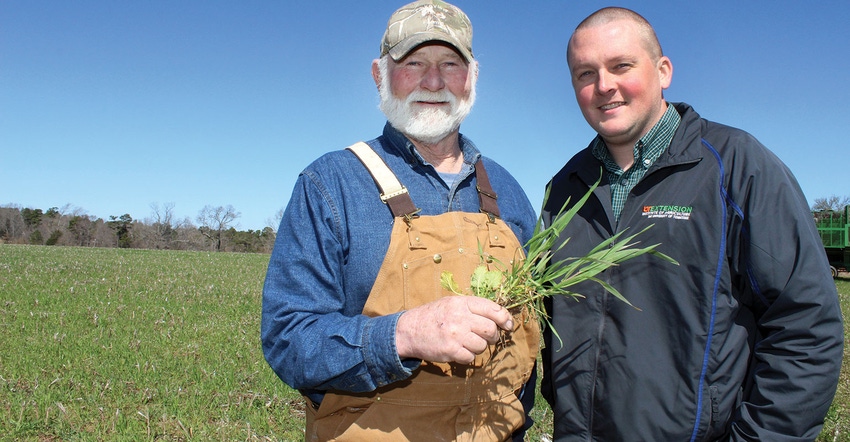
Hickory Valley, Tenn., producer Barry Lake has been planting cover crops for 15 years. He knows they retain moisture, improve soil, promote infiltration, and generate nitrogen.
The National Resources Conservation Program (NRCS) supports Lake's cover crop efforts through its Environmental Quality Incentives Program (EQIP), but he focuses on other benefits. "We received around $53 an acre through the program, but the real values I'm getting from cover crops are the agronomic benefits in my crops and soils each year," Lake says. "I estimate they provide 20 to 30 pounds of nitrogen per acre each year and that's 20 to 30 pounds less fertilizer I have to purchase and apply."
He uses a five-species blend of wheat, cereal rye, crimson clover, turnips, and vetch and, to get a better stand, prefers to drill it in with a no-till drill around September or October. If there is enough moisture those months, he will broadcast it with a spreader truck, or has it applied aerially before a rain with another rain predicted behind it.
Lake has seen soil health improvements.
"Micro-organism activity in the soil slows during the winter months if I don't sow a cover crop," Lake says. "Cover crop root nodules are the source point for nitrogen to the soil. I plant my corn straight into the live cover.
Lake sees another benefit from the combination of cover crops and no-till — less compaction. "I can get into my fields sooner," he says. "That's a real advantage if we get a short weather window for planting."
Essential element
Although some farmers do not credit cover crops for increased yields, Lake sees them as an essential element in his cotton yields and to a degree in his corn yields.
"I made three bales an acre last year on dryland ground that's had continuous cotton on it for 15 years. My corn yields haven't increased as appreciably as my cotton yields, but I did average 200 bushels in my field middles last year," Lake says. "I attribute that to variable rate, no-till and cover crops."
Most of Tennessee's corn, like Lake's, is no-till. He splits his nitrogen applications. "I'll put out 50 units at planting and come back with 80 to 120 more units when it gets knee-high if it needs that much," Lake says. "I may use my knifing rig to put out 32 percent liquid nitrogen, but if I run out of time, I'll put out granular with a spreader truck."
The local co-op handles Lake's soil sampling. "I like my ground sampled on 5-acre grids and base variable rate nutrient applications on those results. "If I see a spot that looks like it requires a little more, I'll go back, pin that spot and have an extra sample taken there to ensure I get fertility where it's needed," Lake says. "Once that's done, I'll wait until soil temperature is around 55 degrees before putting in corn."
Lake has been using variable rate nutrient applications since 2000. "Before spreader trucks had variable rate technology, I spread 1,500 pounds of lime per acre, holding a colored map in my hand while giving my cousin driving the spreader truck turning instructions to keep on path," Lake says. "My biggest input savings each year comes from applying variable rate lime."
Lake pays between $35 to $50 a ton for lime. "We have some spots requiring as much as 2 tons an acre, and some needing only a half a ton," Lake says. "The savings comes from not spreading 2 tons across the entire field."
Josh German, Extension agent, Hardeman County, Tenn., has known and worked with Lake for years. He sees the improvements cover crops make on Lake View Farms. "More farmers in our area of the state are adopting cover crops for the benefits they offer," he says. "The EQIP program continues to attract farmers through its incentives. It's a qualification program based on accrued points."
About the Author(s)
You May Also Like




